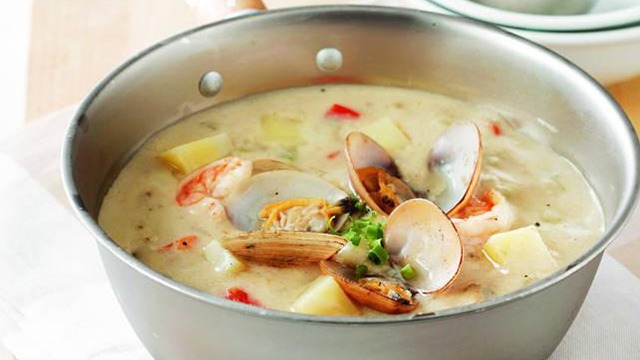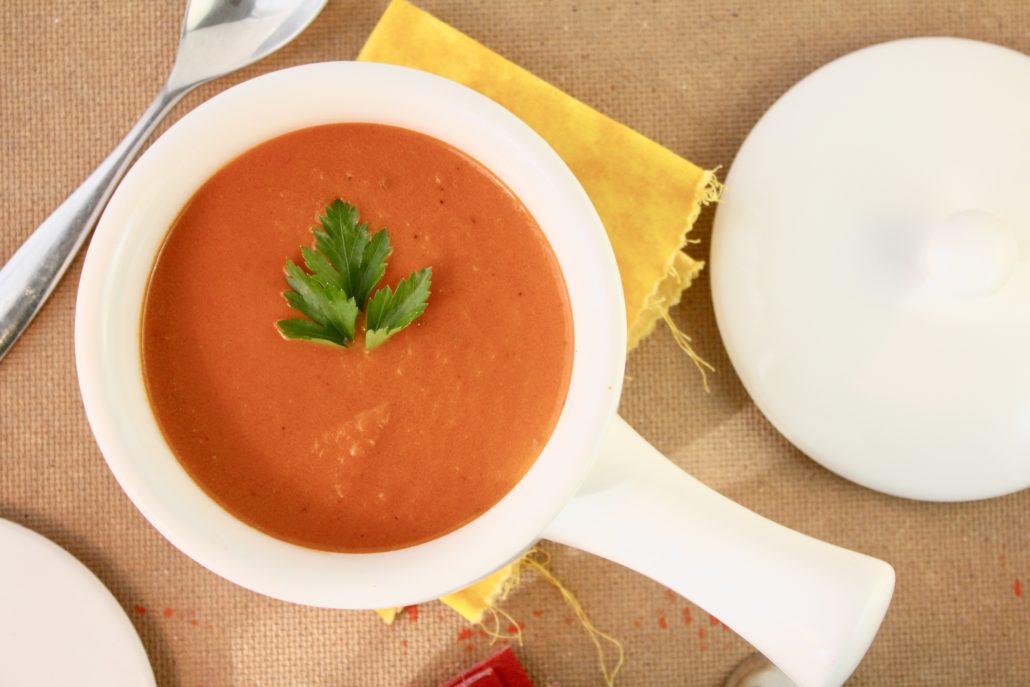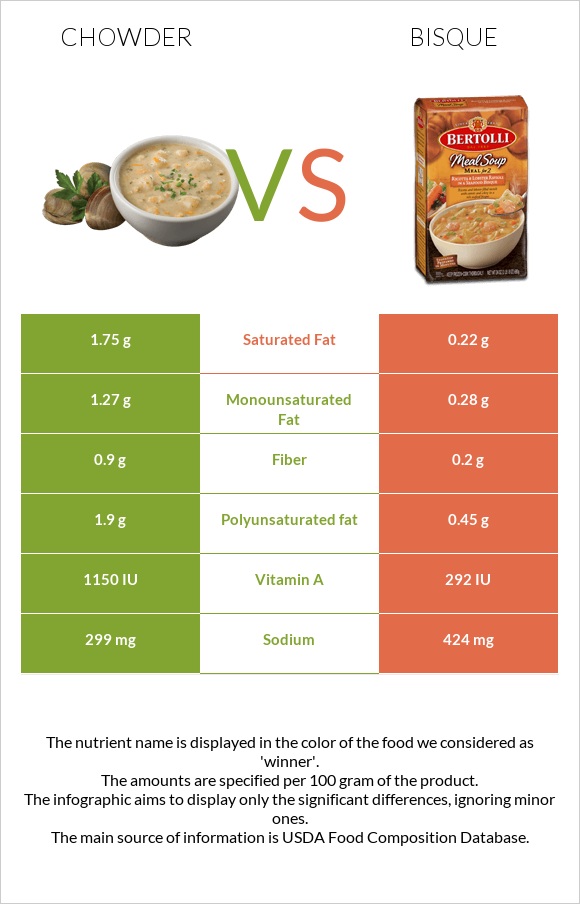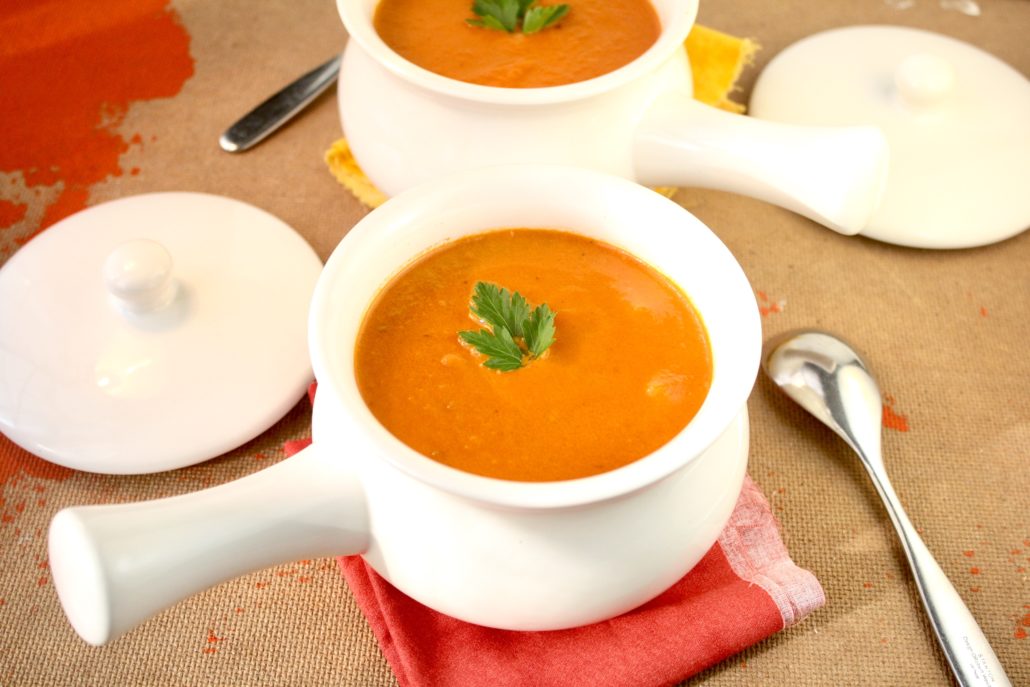Understanding Chowder, Soup, And Bisque

When it comes to creamy delights, it’s important to understand the differences between chowder, soup, and bisque. Chowder is a hearty dish known for its chunky texture and is often made with ingredients like potatoes, clams, or corn. Soup, on the other hand, is a comforting and versatile dish that comes in many types and varieties. It can be made with a variety of ingredients and is often enjoyed for its soothing qualities. Lastly, bisque is a luxurious and flavorful delicacy that is smooth and typically made with seafood. Each of these creamy delights has its own unique characteristics and flavor profiles, making them an irresistible choice for any meal.
A Definition And Characteristics Of Chowder
Chowder is a hearty and thick soup that is known for its rich and creamy texture. It is typically made with ingredients like potatoes, onions, and various types of seafood, such as clams or fish. One defining characteristic of chowder is its chunky consistency, as it often contains large pieces of ingredients. It is commonly seasoned with herbs and spices to enhance the flavors. Chowder is a popular dish in American cuisine, particularly in coastal regions. It is enjoyed for its comforting and satisfying nature, making it a perfect choice for chilly days.
B Definition And Characteristics Of Soup
Soup is a versatile dish that can be enjoyed in various forms and flavors. It is a liquid-based dish that is typically made by simmering a combination of vegetables, meat, or seafood in a broth or stock. One defining characteristic of soup is its liquid consistency, which can range from thin and clear to thick and hearty. Unlike chowder, soup does not have a specific chunky texture, allowing for a smoother and more refined eating experience. Soups can be seasoned with a variety of herbs, spices, and other ingredients to enhance the flavors and create unique taste profiles. Whether enjoyed as a comforting bowl of chicken noodle soup or a spicy bowl of tom yum soup, the possibilities are endless when it comes to soup.
Deciphering Creamy Delights: Chowder, Soup, And Bisque Differences

When it comes to deciphering the differences between chowder, soup, and bisque, one can focus on the creamy and delightful aspects that set them apart. Chowder, known for its hearty texture and chunky ingredients, offers a satisfying and substantial eating experience. Soup, on the other hand, offers a range of consistencies from thin and clear to thick and hearty, allowing for a more refined and smooth dining experience. Bisque, with its smooth and creamy texture, is a luxurious delicacy that often features seafood as its star ingredient. These distinctions in texture and ingredients make each creamy delight unique and enjoyable in its own way.
A Ingredients And Texture Variations
The main differences between chowder, soup, and bisque lie in their ingredients and textures. Chowders are known for their hearty and chunky texture, typically featuring ingredients such as potatoes, seafood, and vegetables. Soups, on the other hand, can have a wide range of consistencies, from thin and clear to thick and creamy, and can include various ingredients like meats, vegetables, and grains. Bisques are characterized by their smooth and creamy texture, often achieved by blending the ingredients and straining them to remove any solids. Seafood, particularly shellfish, is a common ingredient in bisques.
B Flavor Profiles And Regional Variations
Flavor profiles and regional variations play a significant role in distinguishing chowders, soups, and bisques. Chowders often have a rich and savory flavor, with ingredients like bacon, clams, or corn contributing to their distinct taste. New England clam chowder, for example, is known for its creamy texture and briny flavor. Soups, on the other hand, can range from mild and comforting to bold and spicy, depending on the ingredients and seasonings used. Regional variations like French onion soup, Thai tom yum soup, or Mexican tortilla soup showcase the diversity of flavors worldwide. Bisques, being typically made with seafood, have a luxurious flavor that combines the sweetness of shellfish with creamy richness. Lobster bisque is a renowned example of a flavorful and indulgent bisque. These regional variations highlight the unique culinary traditions and ingredients associated with different cultures and regions.
Chowder: A Rich And Hearty Dish

Chowder is a beloved dish known for its rich and hearty qualities. Originating in the United States, chowder is a creamy soup-like dish that is filled with chunks of ingredients like clams, potatoes, and sometimes bacon. The addition of cream or milk gives chowder its luxurious and velvety texture, making it a comforting and satisfying meal. Popular varieties of chowder include New England clam chowder, corn chowder, and seafood chowder. Whether enjoyed on a cold winter day or as a main course at a summer cookout, chowder is a flavorful and indulgent dish that is sure to please any palate.
A Chowder Origin And History
Chowder has its origins in the United States, specifically in the New England region. The dish can be traced back to early fishermen in the 18th century, who would make chowder using ingredients readily available to them, such as fish, clams, and vegetables. Chowder quickly became a staple dish along the coastal areas, providing sustenance and warmth to the hardworking fishermen. Over time, different variations of chowder emerged, reflecting the local ingredients and culinary traditions of different regions. Today, chowder has become a beloved and iconic dish in American cuisine, enjoyed by people across the country.
B Popular Chowder Varieties
Popular Chowder varieties are known for their regional variations and unique ingredients. Here are some of the most well-known Chowder varieties:
- New England Clam Chowder: This classic Chowder typically features clams, potatoes, onions, and bacon in a creamy, rich broth.
- Manhattan Clam Chowder: Unlike its New England counterpart, Manhattan Clam Chowder is tomato-based and includes clams, vegetables, and sometimes even spices like Tabasco sauce.
- Corn Chowder: A delightful summer variation, Corn Chowder combines fresh corn kernels, potatoes, onions, and cream for a sweet and creamy soup.
- Seafood Chowder: As the name suggests, this Chowder incorporates an assortment of seafood like shrimp, scallops, and fish, along with vegetables and herbs.
- Smoked Salmon Chowder: This unique variation highlights the smoky flavors of salmon, complemented by potatoes, onions, and dill for a delectable soup.
Each of these Chowder varieties has its own distinct character, offering a taste of the local flavors and culinary traditions of different regions.
Soup: A Comforting And Versatile Dish

Soup is a versatile dish that offers comfort and nourishment. It can be made with a variety of ingredients, including vegetables, legumes, meats, or seafood. The beauty of soup lies in its flexibility, as you can customize it to suit your taste and dietary preferences. Whether it’s a hearty minestrone, a soothing chicken noodle soup, or a spicy curry soup, there is a soup for every palate. Soups are also a great way to use up leftovers and reduce food waste. Additionally, soups are known for their comforting qualities and can provide warmth and satisfaction on a chilly day. With their endless possibilities, soups are a go-to option for a satisfying and delicious meal.
A Soup Types And Varieties
There are numerous types and varieties of soups that cater to different tastes and preferences. From clear broths to thick and creamy options, soups offer a range of flavors and textures. Some popular types include vegetable soup, chicken noodle soup, tomato soup, minestrone, and clam chowder. International cuisines also contribute to the diverse soup repertoire, with examples like pho, gumbo, miso soup, and gazpacho. Whether you prefer a light and refreshing soup or a hearty and filling one, there is a soup type and variety to suit every palate.
B Benefits And Nutritional Value Of Soups
Soups offer numerous benefits and are also packed with nutritional value. They are a great way to increase your vegetable and fiber intake, as many soups are loaded with nutritious vegetables and legumes. Soups can also be used as a tool for weight management, as they are often low in calories and can help you feel fuller for longer. Additionally, soups can be a great source of hydration and can help keep you warm during colder months. With their versatility and ability to accommodate a variety of ingredients, soups can be a healthy and satisfying addition to any diet.
Bisque: A Luxurious And Flavorful Delicacy

Bisque, often considered a delicacy, is a luxurious and flavorful dish that stands out among its counterparts. Unlike soups and chowders, bisque is typically made with shellfish, such as lobster, crab, or shrimp. The shellfish is cooked in a flavored liquid, often including wine, herbs, and spices, which enhances its rich flavor. Afterward, the mixture is pureed, resulting in a smooth and velvety texture. The thick and creamy consistency of bisque adds to its luxurious appeal, making it a popular choice for special occasions. Its indulgent nature and distinct taste make bisque a true culinary delight.
A Bisque Vs. Chowder And Soup
When comparing bisque with chowder and soup, the main difference lies in the texture and ingredients used. Bisque has a smooth and creamy consistency, often made with shellfish such as lobster, crab, or shrimp. On the other hand, chowder is creamy but also hearty and chunky, with additions like potatoes and bacon. Soup, in general, has a thinner consistency and can be made with a variety of ingredients. While bisque is considered a luxurious delicacy, chowder and soup are more comforting and versatile. Each of these dishes offers its own unique flavors and characteristics, catering to different culinary preferences.
B Cooking Techniques And Serving Suggestions
When it comes to cooking techniques for chowder, soup, and bisque, there are a few key points to keep in mind.
For chowder, it is important to simmer the ingredients slowly to allow the flavors to meld together. Be sure to cook the potatoes and other vegetables until they are tender.
When making soup, the cooking time will vary depending on the type of soup and the ingredients used. Some soups may require longer cooking times to fully develop their flavors.
For bisque, the key is to puree the ingredients until smooth and creamy. This can be done using a blender or food processor for a velvety texture.
When it comes to serving suggestions, chowder is often served in bread bowls or alongside crusty bread. Soup can be served as a starter or a main course, paired with a salad or sandwich. Bisque is commonly served with a garnish of fresh herbs or a dollop of sour cream.
Overall, the cooking techniques and serving suggestions for each of these creamy delights can be customized to suit your taste and presentation preferences. Enjoy experimenting and savoring the rich flavors of chowder, soup, and bisque.
Conclusion

In conclusion, chowder, soup, and bisque each offer their own unique characteristics and flavors that can satisfy different taste preferences. Chowder is a rich and hearty dish, while soup is comforting and versatile. Bisque, on the other hand, is a luxurious delicacy known for its velvety texture. Understanding the differences between these creamy delights allows you to appreciate their individual qualities and choose the one that best suits your cravings. Whether you prefer the chunkiness of chowder, the versatility of soup, or the indulgence of bisque, these dishes are all delicious choices for any meal.
A Summary Of Differences And Similarities
Chowder, soup, and bisque may all fall under the category of creamy delights, but they have distinct characteristics that set them apart. Chowder is known for its rich and hearty texture, while soup offers versatility with a variety of ingredients. Bisque, on the other hand, is luxurious and velvety, often made with shellfish or vegetables.
Despite their differences, these dishes share some similarities. They all strive to provide comfort and satisfaction with their delicious flavors. They also offer a way to incorporate a multitude of ingredients, making them great options for using up leftovers or creating unique flavor combinations.
Whether you prefer the heartiness of chowder, the versatility of soup, or the indulgence of bisque, each of these creamy delights has its own unique appeal and can be enjoyed in a variety of settings.
B Tips For Making The Perfect Chowder, Soup, Or Bisque
When making the perfect chowder, soup, or bisque, there are a few tips to keep in mind. Firstly, always start with fresh ingredients to ensure the best flavor. Secondly, consider layering the flavors by sautéing onions, garlic, and herbs before adding the main ingredients. This will enhance the overall taste of the dish. Additionally, don’t be afraid to experiment with different ingredients and seasonings to create unique flavor combinations. Lastly, when it comes to texture, remember to adjust the thickness of the dish by adding more broth or cream as needed. With these tips in mind, you’ll be able to create a delightful and satisfying chowder, soup, or bisque every time.
FAQ About Chowder Vs Soup Vs Bisque: Deciphering Creamy Delights
Q: What is the main difference between chowder, soup, and bisque?
A: The main difference lies in their consistency and ingredients. Chowder is a thick soup usually made with milk or cream and contains chunks of seafood or vegetables. Soup is a liquid food typically made by boiling meat, fish, or vegetables in stock or water. Bisque is a smooth, creamy soup made from pureed seafood, vegetables, or fruits.
Q: Are there any specific regional variations for these dishes?
A: Yes, there are several regional variations. For example, New England clam chowder is a popular type of chowder that includes clams, potatoes, onions, and sometimes salt pork. French onion soup is a well-known soup originating from France, made with caramelized onions, beef broth, and topped with cheese or croutons. Lobster bisque is a classic French bisque made with lobster, cream, and cognac.
Q: Can vegetarians or vegans enjoy these dishes?
A: Yes, vegetarians and vegans can enjoy chowder, soup, and bisque by using plant-based ingredients such as coconut milk, vegetable broth, tofu, or mushrooms as substitutes for dairy or meat. There are many delicious plant-based recipes available for these dishes.
Q: How can one determine the best dish choice for a specific occasion?
A: The best dish choice depends on personal preferences and the occasion. Chowder is hearty and ideal for cold winter days or as a comforting meal. Soup is versatile and can be served as a starter, main course, or side dish. Bisque is elegant and perfect for special occasions or fine dining experiences.
Q: Are there any health considerations to keep in mind when consuming these creamy delights?
A: While chowder, soup, and bisque can be nutritious and full of flavor, it’s important to be mindful of portion sizes and ingredients. Cream-based dishes may be high in calories and fat, so individuals with dietary restrictions or health concerns should opt for lighter versions made with low-fat dairy or alternative ingredients. Additionally, individuals with allergies should check for potential allergens in these dishes.

Salsas by Karoll’s Catering is a vibrant and innovative Canadian fusion family restaurant that welcomes you to indulge in a delightful culinary experience. Every Sunday, from 11 am to 2 pm, we invite you for a delicious brunch that will tantalize your taste buds. Whether you prefer dining in or taking out, we ensure that our delectable dishes are available to savour at your convenience. In addition to our enticing Sunday brunch, we host a lively happy hour every Thursday, Friday, and Saturday. During this time, you can enjoy discounted food items, get $2.50 off on beer, and sip on refreshing $5 margaritas. It’s the perfect opportunity to unwind and relish in the flavours of our Canadian fusion cuisine.